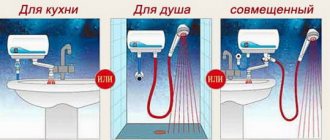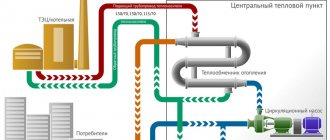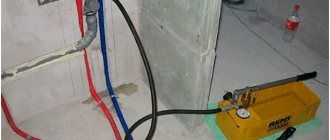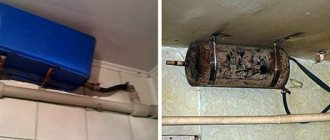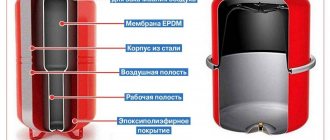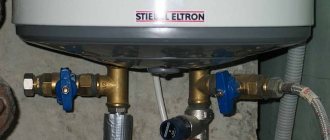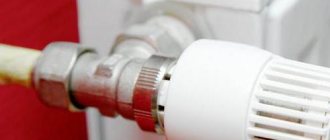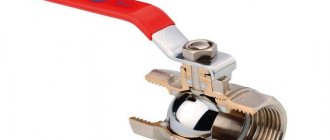How to properly drain water from a heating battery?
Drain the water from the heating system, what could be easier? Connect the drain hose, open the tap and pour out the water. Meanwhile, an incorrectly performed operation to drain water from the circuit is fraught with unpleasant consequences. In autonomous systems, draining water usually does not cause difficulties, unlike the circuits of apartment buildings? After all, mistakes due to ignorance of basic rules lead to the creation of unpleasant situations. For example, you can flood the neighbors below with water.
When and why is water drained?
For any intervention in the heating circuit, which is associated with the replacement of its elements, it is necessary to drain the water from the heating system, because it is impossible to carry out work on a system filled with water.
The main list of works requiring the removal of coolant from pipelines and batteries is as follows:
- replacement of radiators;
- eliminating leaks;
- preventive maintenance, removal of contaminants;
- replacement of coolant.
Draining coolant from an autonomous system
The process of removing water from pipelines and batteries of an autonomous heating system of a private house does not require any permission or approval. What needs to be done next and how to drain the water from the heating system is described below.
The following simple rules must be followed:
- turn off the boiler (of any type) and allow the coolant to cool;
- close the cold water make-up valve;
- open the air valves (for a closed system).
In a properly installed system, there is a drain valve located at the lowest point of the system. It is usually located on the return pipe near the boiler. A hose is connected to the drain tap, through which water is removed from the circuit. After the water has been completely removed, you can begin to realize the purpose for which the coolant was drained. If heated floors are installed, then water can be removed from the pipelines only by connecting a compressor to the inlet pipe to displace it with air pressure.
However, situations often arise that do not require complete drainage of the water. For example, replacing or repairing a separate battery. The answer to the question - how to drain water from a heating battery - is simple if the design of the system has been carefully thought out and installed. To make this operation easy and quick, even when designing the circuit, it is necessary to provide for the possibility of cutting off the radiator from the system, without disrupting its operation.
Let's assume that all the recommendations have been followed, the battery is disconnected from the system by shut-off valves on it, but how to drain the water from the heating battery if there is a very significant amount of water in it, especially if the battery is cast iron. Therefore, it is necessary to install a container of sufficient volume to collect leaking water when disconnecting the radiator from the circuit. If the homeowner does not have the necessary skills, or does not understand how to drain the water from the heating system, then it is better to invite a heating specialist.
Draining water from heating systems of multi-storey buildings
If the apartment is located in a multi-story building, then such an operation is complicated by several factors. When performing repair or modernization work on the heating system, it is necessary to drain the water from the riser. To do this, you need approval from the company that services the heating of the house. Every resident should know where to go regarding heating if problems arise. The water drainage service is paid, and during the heating season it is extremely expensive and hourly. Therefore, it is better to plan the work for the summer period, when the coolant is drained, but permission to carry out the work and shut off the riser must be obtained.
Replacing a radiator in an apartment building
If you only need to change the radiator for repairs, then every apartment owner must know how to properly shut off the radiator. If the system in the house was installed in good faith, then this possibility certainly exists.
By closing the shut-off valves at the battery inlet, which stops the water supply to the radiator, but does not stop the circulation of water in the heating system, you can begin to replace the battery. Further actions depend on the availability of the outlet valve. If there is one, then the water is drained through the tap, but more often it is not, so the drain is performed when the inlet or outlet pipe is disconnected. You should place a container for water so as not to flood your neighbors.
Knowing how to shut off a heating battery is also necessary to prevent various emergencies, such as a severe leak due to the destruction of the radiator. Every owner needs to know the phone number of the organization where to contact about heating immediately in the event of an emergency.
If a single-pipe heating scheme is used, then a bypass must be installed. Every apartment owner should have a clear and precise understanding of how to shut off the heating radiator in this case.
With such a circuit diagram, the following actions are carried out:
- the bypass valve opens completely;
- close the shut-off valves on the battery on both sides.
Having completed these operations, you can begin to remove the radiator from the system.
After replacing the battery, sealing the connections and tightening the locknuts, gradually open the valves at the battery inlet and outlet.
At the same time, the Mayevsky tap opens and the bypass closes. Slowly filling the battery prevents water hammer, and the air from the battery is released through the Mayevsky tap until water appears. This will mean that the battery is filled with liquid, the air has been removed, and the shut-off valves on the battery can be opened completely.
Some heating problems that do not require draining
Most often, heating problems are associated with the fact that water does not circulate in the heating system, for various reasons.
There are many reasons and the most common are:
- presence of air in the heating circuit;
- system contamination;
- pipeline diameter is too small;
- the power of the circulation pump is insufficient;
- in complex systems there are no check valves;
- violations during installation of the system.
Many disturbances in heating systems are interconnected, for example, water babbling in heating pipes. This phenomenon can cause discomfort and complaints - the heating radiators in the house make noise. Each person perceives the sounds that a heating system may produce differently. Some people think that the heating is humming, others perceive these sounds as humming. Unpleasant sounds include knocking on radiators during operation of the system.
Noises in heating circuits are phenomena of the same order and there are quite a lot of reasons that cause them:
- the presence of air in the system, it must be removed;
- constant air leaks due to poor sealing of connections;
- coolant speed is too high;
- malfunction of the expansion tank (closed system);
- estrus in the system;
- incorrect connection of the thermal valve;
- errors in the design or during installation of the circuit.
The reasons listed are the most common. In any case, if various unpleasant noises appear in the heating system that were not there before, you need to carefully inspect and analyze the operation of the circuit. Once the fault has been located, it must be eliminated. But if you can’t find and fix the problem yourself, then you need to contact a specialist.
spetsotoplenie.ru
Expansion tank
Another reason is the expansion tank. This is a sealed container divided in half by a membrane, one half of the tank is filled with inert gas or just air, the other is filled with coolant (read water).
Expansion tank
It is designed to compensate for the pressure created during the expansion of the heated coolant.
When heated, the water in the system expands and fills its half of the tank, compressing the gas; when cooled, the coolant is again pushed into the heating system.
This is how temperature expansion in the heating system is compensated.
But sometimes the tank itself may malfunction.
Expansion tank malfunctions
For example, the tank body has lost its tightness and air is escaping from it. This does not happen often, and usually results in a fairly rapid decrease in pressure in the tank, from almost instantaneously to several days.
Also pay attention to the spool so that it does not poison the air either.
The spool (as in a car or bicycle) is located in the upper part of the tank; air is pumped through it, thereby creating the necessary pressure in the expander tank.
Another bad problem with the expander is the rupture of the membrane inside the tank, although it is not so delicate, and you need to “try” hard to break it. But if this happens, then identifying such a problem is not difficult.
In this case, the coolant enters from the heating system into that part of the tank that should be filled with air, and if pressing the spool needle throws water out of the tank, then water has penetrated where it should not be - the tank needs to be replaced.
But most often the pressure in the tank decreases very slowly, due to minor natural leaks. This decline occurs over many months or several years.
At the same time, the pressure in the expander chamber gradually decreases; naturally, it will also decrease in the readings of the boiler pressure gauge.
The behavior of the boiler very much depends on the level of this same pressure in the expander and can manifest itself in different ways. Under the next heading you will find a description of these problems.
How should you drain water from a gas boiler?
Select a boiler
During long-term operation of an autonomous space heating system, the user sometimes has to drain water from the radiators and from the gas boiler. To avoid damaging your expensive gas appliance, flooding the room, and harming yourself, follow the instructions below.
Rules for draining water from a gas boiler:
- Turn off the water heating following the equipment manufacturer's instructions.
- We turn off additional equipment that ensures the circulation of working fluid through the heating system.
- We turn off the taps that disconnect the radiators from the boiler.
- If you are using a double-circuit boiler, then turn off the taps that turn off the hot water supply system and the cold water source from the heating equipment.
- We turn off the gas.
- We check that the boiler is not functioning and the water in it is not heating up.
- We are waiting for the temperature of the water in the boiler to drop to about 30 degrees.
- We check the reliability of the connection between the drainage system and the sewer system.
- Open the tap to drain water from the gas boiler.
- Open the tap located at the water inlet to the boiler.
Draining water from the hot water supply system:
- Check the position of the tap on the pipe supplying cold water to the boiler.
- Open the drain valve.
- Open the tap located in front of the check valve.
The information is not a public offer.
The prices indicated are recommended; the company reserves the right to change prices. www.thermona-rus.ru
Preparatory work
The first thing you need to do when starting this work is to turn off the boiler and turn off the taps at its inlet. However, this last operation is not necessary in some cases.
For example, if the boiler is located at the highest point of the heating system and you only plan to remove the primary heat exchanger or drain the water from the expander.
But if you plan to disassemble the hydraulic unit, remove any components from it, for example, a water flow sensor or a make-up valve, remove the secondary heat exchanger, etc. then turning off the tap at the inlet is a must!
But however, if in doubt, block it in any case, it won’t hurt.
Then you need to prepare a five-liter container, it’s a good idea to find a 1.5-meter piece of hose, and a rag may also come in handy.
How to drain water from pipes for the winter
With the advent of the first cold weather, many owners of private houses and summer cottages have a need to drain water from the pipes of their plumbing and heating systems. Many people think about how to drain water from pipes with their own hands, they think that it is very difficult, and the help of specialists is needed. In fact, you can do this on your own.
Adviсe
Draining water from water pipes
When preparing water pipes for conservation, it is worth remembering that all work must be carried out at an outside air temperature of at least 5 ⁰C.
In order to properly drain water from water pipes, their design must include the following details:
- A tee and a drain valve must be installed on the pipe valve supplying water from a well or well caisson.
- Water pipes must be made of low-density polyethylene or polypropylene. This will prevent them from being damaged during emergency defrosting.
- A water drain valve must be installed at the lowest point of the pipeline branch.
- If drain taps are not installed, a tee must be installed. A car compressor is connected to it. It is used to blow through pipes.
- If a water heater is connected, it is necessary to install a tee and a tap to drain the water. They must have a hose attachment to the check valve on the incoming water heating pipe. Also, a tee with a tap should be installed on the outlet pipe from the water heater to quickly supply air when draining the water.
Note! It is recommended to use classic ceramic faucets and taps with a rubber seal. They will not be damaged if residual water in the pipeline freezes.
Stages of draining water from a pipeline
Stages of draining water
To drain water from the heating system, you must perform the following steps:
- Turning off the heating boiler or closing the distribution valve on the pipe extending from the riser.
- Shutting off the valve that collects water into the heating system.
- A hose must be attached to the radiator system drain valve. Here you should correctly calculate its length. It must be sufficient to drain water into the street or into a sewer well.
- The drain valve on the heating radiator must be opened.
- On the heating system, it is necessary to open the valves with air valves. This will ensure a faster drainage rate.
- Leaks may occur during the draining procedure. To avoid unpleasant incidents, it is necessary to place a deep container in advance and place it under the junction of the tap and the drain hose.
- After completing the draining procedure, you must disconnect the hose and drain the remaining water into a container.
We drain water from the central and autonomous water supply
Drainage from a water supply system in a dacha
In modern dacha plots, many install a pipeline system. The pipeline can be connected:
- to the central water supply,
- to an autonomous water supply system.
If you need to drain water from the central pipeline during the winter, you must perform the following steps:
- Shutting off the water supply to the room. To do this, close the tap located on the inlet pipe.
- Opening all pipeline taps to drain water.
Draining from the tap
To drain water from the pipes at your dacha for the winter from an autonomous pipeline system, you must do the following:
- If the water supply is from a well, the pump must be removed from it.
- It should be preserved for the cold period in accordance with the operating instructions.
- If you are using a container with a storage system, you must open the drain valve on it.
- Where water is consumed, taps should also be opened to drain the piping system.
- To completely remove water from the pipeline, it is necessary to additionally blow it out using a compressor.
- If the storage tank is not used, you simply need to open all the taps on the pipeline system and drain the water.
Extreme situations
If water is not drained from the pipeline in a timely manner, the system may freeze. What to do in this case?
How to solve the problem depends on the type of pipeline installation. He can be:
If an open type pipeline is used, solving the problem of pipe freezing is quite simple. To do this you just need to heat it up. A blowtorch can easily handle this.
Blowtorch for defrosting
If the pipeline is buried in the ground, and even hidden by a layer of insulation, solving the problem of pipe freezing is much more difficult. To do this, you need to connect a hose to the hot water supply system. It should be placed inside the pipeline and moved along the pipe to the place where the ice has formed. After this, the hot water tap opens. The water will melt the resulting glaciation.
To avoid problems with freezing of the pipeline, it is necessary to drain the water in the pipes in a timely manner.
Last edition: 02/20/2015 Author: Natalie Yudakova
trubyinfo.ru
Draining the coolant from the heating riser
A properly functioning heating system is an essential component of comfortable living in a house or apartment. Occasionally there is a need to replace radiators, fix leaks in the network, move or move the riser closer to the wall.
Any work on the system requires draining the coolant. And this is understandable. After all, it is impossible to open pipes when the network is full. Therefore, before starting repair and maintenance work, you need to drain the heating riser.
Who should do this?
The management company is responsible for the serviceability of communication networks in apartment buildings. The drainage of the heating riser must be agreed upon with them. And most often, invite their own specialists. Hence the questions and ambiguities:
1. Can I choose my own date?
Almost impossible. The management company itself determines the day and time. You can ask to drain the water from the system within a certain time frame only through great connections.
2. At whose expense is the heating riser drained?
Only at the expense of the tenants. They will ask for money both for the approval procedure and for the participation of specialists. Tariffs in different regions and in different companies vary greatly. It is impossible to predict the amount. In one town they will ask for a thousand, and in another - five. The price includes turning off the system, draining the coolant and then filling the network.
If repairs need to be done at the height of the heating season, you will have to convince the management company of the dire need and pay many times more. If it’s below thirty degrees outside, no one will turn anything off. The only exceptions will be emergency situations.
Is it possible to do without draining the riser?
Minor repairs or simply replacing the battery do not require draining the entire heating system. In almost all apartments, you can shut off a separate radiator without affecting the general circuit.
1. Turn the corresponding tap on the heating riser and shut off the coolant supply.
2. Open the outlet valve on the radiator or unscrew the cap using an adjustable wrench. Drain the water into a container.
If there is neither a plug nor a tap, then disconnect the heating battery and drain the coolant. This will turn out to be more difficult and dirtier, but there is no other way.
Sometimes, for minor repairs, you do not need to drain the water, but simply shut off its supply to the internal circuit.
Draining a heating riser in a private house
The owner of a private house can drain the coolant himself at any convenient time. First he needs to find the taps that shut off the riser.
There are several types of heating systems. There are quite a lot of them, but their operating principles are similar. It is important to get the point:
- find the necessary shut-off valves;
- shut down the network;
- drain the coolant.
Let's look at the example of individual circuits.
The first picture shows a heating system with bottom supply. In it, the supply and return pipes are located in the basement or ground floor. The coolant is supplied from below, goes through the “idle” riser to the upper floor and returns through the heating devices through another riser. If the house has such a heating system, then two pipes located nearby are visible in the rooms.
How to drain a heating riser?
1. Close the valves on the supply riser (1) and return riser (2).
2. Open the drain valves (3) and drain the coolant.
Closed valves 1 and 2 should not let water through. They may only drip a little.
The second picture also shows a system with bottom feed. Only the supply and return risers are located in different rooms. Therefore, taps 1 and 2 can be spaced apart. And the procedure for draining the coolant is the same.
The third picture shows a system with top coolant supply. The supply line is located in the attic or under the ceiling of the upper floor.
Procedure for draining the heating riser:
- close valve 1 in the attic;
- find valve 2 in the basement and turn it off too;
- remove plug 3 and drain the coolant.
The same systems are made in multi-storey buildings.
stroy-king.ru
How to add water to heating: instructions for closed and open systems
As a rule, the initial filling of the heating system is carried out by the specialists who installed it. However, during operation, situations may arise when this procedure has to be carried out independently. This usually occurs during repairs that involve complete or partial emptying of the system.
Table of contents:
How to distinguish a closed heating system from an open one
The process of filling heating with water largely depends on its design:
- Open. This system uses natural circulation of coolant (usually water) when there is no additional pressure. Its operation is based on the elementary laws of thermodynamics: the liquid circulates slowly here, because an additional pump is not used. At the highest point of the open circuit, a special expansion tank is installed to compensate for the increase in water volume when heated. This container absorbs excess water as it expands, returning it back when cooled. The tank is not sealed, so liquid constantly evaporates from it: its volume must be replenished from time to time. The boiler in an open system, as opposed to the tank, should be mounted at the very bottom of the circuit.
Open heating system
- Closed. A completely sealed system in which the heated coolant moves under the influence of a circulation pump. Closed-type heating is also equipped with an expansion tank, but unlike an open system, it is completely sealed and can be installed at any point in the system, not just on top. Inside the container there are two compartments, separated by a rubber membrane. The lower part of the expansion tank is filled with liquid, and the upper part is filled with air: thanks to its pressure on the membrane, a comfortable pressure level (1.5 atm.) is maintained in the circuit. As the temperature of the coolant rises, it penetrates through the valve into the expansion tank and compresses the air. After cooling, the liquid is pushed back into the circuit by compressed gas.
Closed heating system
The list of situations when there is a need to fill the heating system with water:
- On first launch. As already mentioned, this procedure is usually carried out by the plumbers who installed the heating system.
- Repair. Preliminary coolant discharge is accompanied by repair activities when it is necessary to repair or replace shut-off valves, a radiator, a section of pipeline, etc.
- After seasonal reset. They try to empty systems with cast iron radiators after the end of the heating season, as this reduces the wear of the intersectional paronite gaskets by an order of magnitude. In addition, in some cases, the coolant can be drained for the winter: this usually happens in country houses that are not used in winter.
- Reduced coolant quality. The liquid inside the system is constantly exposed to critical influences, either heating up or cooling down. This causes sediment to form (if water is used) in the form of lime and rust. For synthetic coolants, such an operating mode can lead to changes in the viscosity level. You should also take into account the fact that in metal circuits the liquid gradually accumulates iron impurities. All this leads to a decrease in heating efficiency and its service life, up to the failure of individual elements. Therefore, there are certain recommendations on the frequency of coolant replacement, depending on the situation. For example, it is recommended to change distilled water in a system with a double-circuit boiler once a year, before the start of a new heating season.
How to add water to a closed heating system
Preparation
Regardless of whether a new, just installed system is being launched, or the circuit has been reset for repair or replacement of coolant, the utility network must undergo certain preparation before filling:
- Drain. Before pouring new coolant into the system, the old one must be completely drained. To do this, turn off the boiler and wait until the water temperature drops to room temperature. Next, by opening the drain valve at the bottom of the heating circuit, drain all the liquid: it must be collected in special containers for subsequent disposal. After waiting until the system is completely emptied, open the Mayevsky valve at its top point - this will allow the pressure in the pipes to stabilize.
Mayevsky crane
- Flushing. It is necessary to remove all debris from inside the circuit - chips, scale, limescale, etc. This is done using a pump connected to the network, which pumps the washing solution inside. It often takes several cycles until the water comes out completely clean. The water for the last rinse is enriched with neutralizers to remove additives in the first portions.
Flushing the heating system
- Pressing. It allows you to test how tight all joints and connections of the system are before filling in the coolant. To do this, create excess pressure inside the circuit by pumping air or using a coolant. To carry out the test, you will need a mechanical (electric) pump. There is also an option to connect the water supply, but this kind of procedure is much more difficult. Before connecting the pump to the inlet pipe of the system, you must carefully inspect all joints and connecting nodes. If no defects were found, excess pressure is created inside the circuit (the norm must be exceeded by 1.5 times).
Manual pressure test pump
- Elimination of leaks. All leaks discovered during pressing must be eliminated. If the flaw is at the junction, then it is repacked, installing a new seal. Leaks in the middle of the pipe are solved by replacing the damaged section.
Before pouring water into the heating system, it is necessary to eliminate all leaks
- Checking the complete set. Before filling a closed heating system with water, it must be checked for the presence of the necessary safety equipment. We are talking primarily about Mayevsky taps, bypasses, thermometers and pressure gauges. If any of these elements are missing, it will most likely cause problems with the heating.
Calculation of coolant volume
In cases where water not from a pipeline is used as a coolant, it is important to know exactly how much liquid is needed.
This can be determined in the following ways:
- When resetting the system, measure the drained liquid using a meter or a special container of known volume. The same method can be applied when flushing and pressing the circuit.
- Separately summarize the volume of elements included in the system. The parameters of the boiler, batteries and expansion tank are indicated in the passport documentation for these products, and the volume of the pipeline is determined using special tables from the plumbing reference book.
Approximate calculation of the volume of a heating radiator
Filling a closed heating system
Having prepared the required amount of coolant, you can begin filling the pre-washed and tested system. The most convenient way to do this is with a vibration pump.
Given the particular importance of this procedure, care will be required when performing it:
- All joints are checked for defects and leaks for the last time.
- Shut off the shut-off valves through which coolant is removed from the heating circuit. This is done to avoid unnecessary fluid loss.
- Test to see if the air valves are working properly. If it turns out that their level of performance is insufficient, it is recommended to fully open the Mayevsky tap during the entire filling procedure. You can also leave the valve open in the upper section of the network, which will significantly speed up the release of air accumulated in the pipes.
Heating system elements
- Begin to pour water through the pipes adjacent to the boiler. In this case, it is advisable to supply the liquid as slowly as possible: in this case, the internal air can be easily discharged through the open fittings. Rushing at this stage usually leads to traffic jams. To avoid water hammer, the tap on the pipe through which water is supplied should be opened no more than halfway.
- As the circuit is filled, all taps and valves from which liquid begins to splash are closed: before starting the process, it is advisable to place an empty basin or bucket near each of them. For this reason, water is stored with a certain reserve, taking into account possible losses.
- When pouring water, it is recommended to change the position of the pump from time to time, switching to higher outlets. This is especially true for filling a closed system in houses with several floors.
- Checking the quality of the filling. To fill the amount of coolant, it is recommended to determine not only the total figure, but also the volume of individual sections of the circuit. This will allow for quality control of filling as it progresses using meters on the inlet pipes. This will allow you to monitor the amount of coolant already pumped in, comparing it with the volume of individual elements of the system. If, after filling a certain area, it turns out that less liquid was used than was calculated, it means that an air lock has formed inside. If the filled volume of coolant exceeds the calculated data, you need to look for the location of the leak.
- Draining excess air. Upon completion of the filling procedure of a closed system, all air must be removed from it. The main pipe is deaerated using an air valve, which is usually located on the boiler. If the circuit uses a forced coolant circulation method, then air is bled from the pumping equipment using an air valve, which is usually located in front of the device.
Automatic air release and air release using a Mayevsky crane
Each radiator must also be freed from air pockets individually, starting with the heating elements on the ground floor. This procedure is very simple: using a key or screwdriver, open the Mayevsky tap, closing it only after water appears in the hole. Finally, you need to check the return flow using the valves installed on it. Having released all the air, the pressure in the closed system must be brought to 1.5 atm, and only then shut off the water supply.
Feeding the system
To ensure efficient operation of a closed heating circuit, the pressure in it must be kept at a constant level. This is directly affected by the volume of coolant circulating through the pipes and radiators. In any case, it will gradually leak out, despite the high level of tightness of the system: replenishment of liquid will be required to make up for these losses. The issue is solved by special make-up valves, which are equipped in areas of the circuit with the lowest pressure (most often, next to the pump, directly in front of it).
Make-up valve
Small houses with low-power heating systems are usually equipped with mechanical valves. In this scheme, compensation for pressure surges occurs thanks to the rubber membrane of the tank. To avoid emergency situations, you have to constantly monitor pressure parameters.
Automatic filling
Double-circuit boilers, as a rule, have a device for automatically filling the coolant. This electronic control unit is installed on the inlet pipe. The convenience of this solution lies in the fully automatic regulation of pressure in the system through timely pumping of liquid.
If the pressure in the network is critically low, a signal from the pressure gauge is sent to the control unit. This, in turn, activates the supply valve, which begins to allow water to flow into the system until the pressure is completely stabilized. However, you have to pay for convenience, which is reflected in the high cost of automatic filling devices.
How to pour water into an open heating system
In order to fill the open heating system of a private house with coolant, a slightly different procedure is used. The main difference from closed networks is the internal pressure of the circuit: here it corresponds to atmospheric pressure, which allows the use of an expansion tank as the main control device. In open heating systems it is mounted above all other elements.
Step-by-step instructions for filling an open heating system with water:
- Draining the old fluid and cleaning the circuit. This is done in the same way as in the case of a closed system.
- To pour water into an open system, an expansion tank is used, which looks like an open tank. Having removed the lid, they begin to pour water: filling a small circuit is usually done with a bucket. Filling large systems in this way is quite tedious, so it is better to use a household vibration pump. To do this, you will need a spacious tank with pre-prepared water. The pump is equipped with flexible hoses on clamps: one end is immersed in a container of water, and the other in an expansion tank.
Extended tank
- It is recommended to supply water slowly so that the air has enough time to escape. When using a vibration pump, you need to ensure that the pressure in the circuit during its filling is within 1.5-2 atm. When it decreases, more water is added to the preparation tank so that the suction hose can be immersed deeper. The water supply is turned off after it begins to pour into the expansion tank.
- At the end of the procedure, it is necessary to free the circuit from air pockets. To do this, open the Mayevsky taps on all existing radiators one by one, closing them only after water appears. To avoid getting the floor wet, it is recommended to place a portable container under the taps. Having released the gas from all batteries, add water to the tank. As practice shows, the final release of air from an open system occurs through an expander after the first combustion.
During intensive use of open heating (most often this happens in winter), the coolant will gradually evaporate through the expansion tank. This is explained by the high temperature of the coolant. To maintain the functionality of the system, it must be periodically topped up, making sure that its temperature does not rise above +80 degrees.
What kind of water is best to pour into the heating system?
There are several types of water poured into the heating circuit:
- Tap water. This also includes liquid taken from a well, a well or a nearby body of water. The main advantage of this option is its low cost. However, the quality of such a coolant is quite low: it has a rather aggressive effect on the internal walls of the circuit due to the salts and oxygen dissolved in it.
- Boiled. Boiling allows you to remove some of the oxygen and salts that precipitate from the water. However, preparing water for a volumetric circuit in this way is quite difficult.
- Purified by reagents. To neutralize harmful impurities, instead of boiling, it is convenient to use special chemicals - reagents. Water prepared in this way needs to be carefully filtered before being poured into the system.
- Distilled. It is sold in plumbing stores in containers of various sizes. Rainwater also has similar properties, which some owners of private houses specially collect for subsequent use in heating networks.
- Antifreeze. They are used instead of water in cases where the heating system is prone to freezing (the crystallization temperature of antifreeze is much lower than that of water). This method of filling the heating circuit is used quite rarely due to its high cost.
Antifreeze for heating
Conclusion
Filling the heating circuit with water is a rather complex and time-consuming procedure, which is recommended to be performed by at least two people. During its implementation, it is important not to rush, carefully following all recommendations. The preparation of water for pouring into the circuit deserves special attention: in cases where, for financial or other reasons, liquid from the water supply is used, it must at least be boiled. To remove sediment and rust particles that gradually accumulate in the coolant, it is recommended to equip the system with special mud filters.
heating repair plumbing pipes
5domov.ru
In what situations is it necessary to drain water?
There are only two such situations:
- If Ariston is left in an unheated house for the winter. The fact is that the water inside the storage tank will simply freeze and burst it. But remember one important thing - the material that has been in the water all the time must remain in it. It's all about the negative effect of water on many materials, especially metal. Under the influence of oxygen, after the water has been drained, this material begins to quickly corrode, so rust in an empty Ariston is common.
- If your water heater needs to be repaired. There are no options here - as long as there is water in the tank, it is impossible to repair Ariston.
Attention! If the service warranty period has not yet expired, then you should not engage in amateur activities. Your task is to call a technician from the service department and hand him the heating device for inspection and repair. All repair work is carried out at the location of the water heater.
How to remove water from a heating system
When do you need to drain water from a heating system? Very often the need for it arises when it is necessary to clean or change a heating radiator, for example. If we are talking about an apartment in the city, which is connected to a central heating system, then such an operation can be carried out on your own on the internal section of the network. In the case when it is necessary to drain the heating system of a privatized house equipped with a boiler, it will have to be emptied for a while.
The essence of the
First of all, it is necessary to close the branch of the heating riser that goes to the living area. It will be enough just to close the distribution valve located here. For a privatized house with an independent heating system, this process is slightly different:
How to quickly release pressure from a boiler
- First of all, it is necessary to stop the supply of fuel or electrically powered energy;
- Second, you should become well acquainted with the client's management for such an occasion.
Only after this can the boiler be turned off. Then you should close the valve through which water is drawn into the system.
Only after this can the boiler be turned off. Then you should close the valve through which water is drawn into the system.
To make the process a little faster, you will need to know those places in the system where taps with air-type valves are usually located. They must all be opened. In this case, nothing will interfere with the process of water flowing to the hose.
During this operation, small leaks of water from the system onto the floor are possible. Therefore, at the beginning it is better to place a large bowl or basin under the place where the hose is combined with the tap (drain). As all the water leaves the system, you need to disconnect the hose and drain the remaining water from it into a substitute container.
Only after completing all the described procedures, proceed to the main thing - to the work for which the water was drained from the heating system of a residential apartment or private house construction.
If the owner of a living space or house is not very clear on how to remove water from the heating supply without bad consequences, then it is better to contact a qualified contractor. For example, to a plumber from a company that operates a particular house.
3.3.Chemical washing
- It begins by pouring a chemically active detergent into the system;
- Softening, peeling and dissolution of solid deposits in pipeline cavities upon contact with a detergent;
- Removing suspension from detergent and solid sediment;
- Filling the system with new coolant.
The duration of residence of the active substance varies from a couple of hours to 10 days and depends on the chemical activity. Depending on the branching of the pipelines, the number of radiators and the type of detergent used, specialists will be able to complete the required amount of work in 1-2 days.



